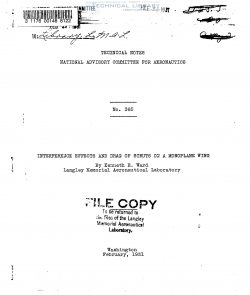naca-tn-365
- Version
- 131 Downloads
- 581.76 KB File Size
- 1 File Count
- November 24, 2016 Create Date
- November 24, 2016 Last Updated
National Advisory Committee for Aeronautics, Technical Notes - Interference Effects and Drag of Struts on a Monoplane Wing

Tests were conducted in the Variable Density Wind Tunnel
of the National Advisory Committee for Aeronautics to determine
the importance of the interference effects and drag of struts
on a monOplane wing. Inclined struts were placed upon a
Gottingen 387 airfoil in two lower surface positions and in two
upper surface positions. Tests were made at values of Reynolds
Number comparable with those obtained in flight. It was found
that the interference drag of struts may be as_great as the drag
of the struts alone. The struts in the lower surface positions
had less effect upon the airfoil characteristics than those in
the upper surface positidns; 'The-reSults justify further in-
vestigation of this subject.
With the increasing popularity of the monoplane greater
attention is being given to the relative merits of the strut~
braced wing and the internally—braced wing. It is well known
that the strutabraced wing is more rigid and lighter than the
internally—braced wing, and that the strut-braced wing can be
constructed at-less cost than the usual internally—braced form,
the tapered wing. The tWO types, however, are difficult to
compare aerodynamically, as little full—scale information is
available on either type of wing.
The present brief investigation was made to determine the
importance of the interference effects of struts upon the aero—
dynamic characteristics of an airfoil at large_Reynolds Numbers.
Tests were conducted in the Variable_Density Tunnel at the
Langley Memorial Aeronautical Laboratorfvppon a thtingen 387
airfoil with inclined struts attached to its upper and lower
surfaces in several positions.
Tests have_also been made on threettapered airfoils suit—
able for internal bracing and the results will be published in
a later report. The two reports will form a basis for comparing
the strut—braced wing and the internally~braced wing.
| File | Action |
|---|---|
| naca-tn-365 Interference Effects and Drag of Struts on a Monoplane Wing.pdf | Download |

Comment On This Post